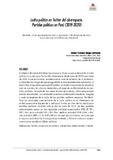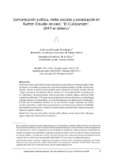Political Struggle on Twitter s Cyberspace. Political Parties in Peru (2019-2020)
Lucha política en Twitter del ciberespacio. Partidos políticos en Perú (2019-2020);
Combate político no Twitter do espaço cibernético. Partidos políticos no Peru (2019-2020)
Compartir este ítem
Fecha
2021-10-04Autor
Aliaga Lodtmann, Cluber Fernando
Citación
Metadatos
Mostrar el registro completo del ítemDocumentos PDF
Resumen
The objective of this work was to know the way in which the political struggle developed in the cyberspace social network Twitter in the period June 2019 - June 2020, determining the level of adherence of the population, effectiveness in the achievement of new followers, level of informative production, effectiveness and type of the disseminated messages, apparent objectives, most recurrent themes, deduced alliances, and the map of conflict of the political parties. It begins with a brief review of the theory and related previous research. The results show an asymmetric, irregular and not homogeneous development of the struggle of the Peruvian political parties. The main characteristics of the political struggle in in the Peruvian cyberspace are identified through the use of the Twitter social network by 10 of the 24 political parties registered with the JNE as of June 2019. Of the 10 selected parties, four have not registered communicative activity (PAP, AP, SP and PPC), two, little activity (FP and PM), two, medium activity (PNP and FA) and two, high activity (APP and C). The PNP and FP are the most confrontational, while the majority try to avoid obvious antagonism, and one (PM) avoids criticism or comments against parties or political leaders. El objetivo del presente trabajo fue conocer la forma en que se desarrolló la lucha política en la red social Twitter del ciberespacio desde junio de 2019 hasta junio de 2020. En este contexto, se determinó el nivel de adhesión de la población, la eficacidad en el logro de nuevos seguidores, el nivel de producción informativa, la efectividad, el tipo de los mensajes difundidos, los objetivos aparentes, las temáticas más recurrentes, las alianzas deducidas y el mapa de conflictividad de los partidos políticos. Se parte de una breve revisión de la teoría y de investigaciones previas relacionadas. Los resultados muestran un desarrollo asimétrico, irregular y nada homogéneo de la lucha de los partidos políticos peruanos. Se identifican las principales características de la lucha política en el ciberespacio en el Perú mediante el empleo de la red social Twitter por diez de los veinticuatro partidos políticos inscritos ante el JNE en junio de 2019. De diez partidos seleccionados cuatro no han registrado actividad comunicativa (PAP, AP, SP y PPC), dos, poca actividad (FP y PM), dos, mediana actividad (PNP y FA), y dos, alta actividad (APP y C). El PNP y FP son los que más confrontan, en tanto que la mayoría trata de evitar el antagonismo evidente, y PM evita críticas o comentarios contra partidos o líderes políticos. O presente trabalho tem como objetivo conhecer a forma como se desenvolveu a luta política na rede social Twitter do espaço cibernético entre os meses de junho de 2019 a junho de 2020. Nesse contexto, foi determinado o nível de adesão da população, a eficácia na obtenção de novos seguidores, o nível da produção informativa, a efetividade, o tipo das mensagens difundidas, os objetivos aparentes, os assuntos mais frequentes, as alianças deduzidas e o mapa do conflito entre os partidos políticos. Parte-se de uma breve revisão da teoria e de pesquisas prévias relacionadas. Os resultados mostram um desenvolvimento assimétrico, irregular e nada homogêneo da luta dos partidos políticos peruanos. Se identificam as principais características do embate político no espaço cibernético no Peru por meio da rede social Twitter nos dez dos vinte e quatro partidos políticos inscritos na JNE em junho de 2019. Dos dez partidos escolhidos, quatro não tinha registrado atividade comunicativa (PAP, AP, SP e PPC), dois, pouca atividade (FF e PM), dois, meia atividade (PNP e FA), e dois, alta atividade (APP e C). O PNP e FP são os que mais confrontam, enquanto que a maioria busca evitar o antagonismo evidente, e PM evita críticas ou comentários contra partidos ou líderes políticos.
Colecciones
Excepto si se señala otra cosa, la licencia del ítem se describe como Attribution-NonCommercial-ShareAlike 4.0 International
Ítems relacionados
Mostrando ítems relacionados por Título, Autor o Palabra clave.
-
Twitter formation of like-minded and dissimilar political communities during the 2015 mayoral campaign in Manizales
López Londoño, Luis MiguelIn the field of political communication, social networks have become an indispensable tool for election campaigns in recent years. In addition to opening communication and dialogue channels that are not available in other ... -
Comunicación política, redes sociales y polarización en Twitter. Estudio de caso: “El Culiacanazo”, 2019 en México
Estrada Rodríguez, José Luis; Martínez de la Rosa, Georgina (Universidad de MedellínFacultad de ComunicaciónMedellín, 2023-08-01)The purpose of this article is to analyze the polarization produced in the social digital network Twitter in relation to the defense or attack of the figure of the President of Mexico, Andrés Manuel López Obrador, during ... -
Colombian presidential campaign in Twitter (2018): Appropriation, communication and subjectivities [Campaña presidencial colombiana en Twitter (2018): Apropiación, comunicación y subjetividades]
Acosta Valencia G.L; Maya Franco C.M; Acevedo-Merlano Á.A; Crawford-Visbal J.L. (ObercomComunicación y Relaciones CorporativasFacultad de Comunicación, 2021)This study analyzes the technological appropriation, communication modes and subjectivities on Twitter during Colombian elections in 2018 by employing a multidisciplinary approach. The method employed started with a virtual ...





